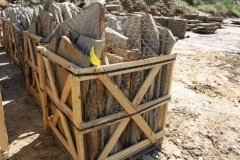Dimension Stone
| Infobox on Dimension Stone | |
|---|---|
| Example of Dimension Stone |  |
| Facts | |
| Origin | Chiefly Brazil, China, India, Italy and Spain |
| Stowage factor (in m3/t) | - |
| Humidity / moisture | - |
| Ventilation | - |
| Risk factors | See text |
Dimension Stone
Description
Dimension stone can be defined as natural rock material quarried for the purpose of obtaining blocks or slabs that meet specifications as to size (width, length, and thickness) and shape. Colour, grain texture and pattern, and surface finish of the stone are normal requirements. Durability (essentially based on mineral composition and hardness and past performance), strength, and the ability of the stone to take a polish are other important selection criteria.
Although a variety of igneous, metamorphic, and sedimentary rocks are used as dimension stone, the principal rock types are granite, limestone, marble, sandstone, and slate. Other varieties of dimension stone that are normally considered to be special minor types include alabaster (massive gypsum), soapstone (massive talc), and various products fashioned from natural stone.
The selector of dimension stone begins by considering stone colour and appearance, and how the stone will match its surroundings. The selector has literally thousands of options to choose from, and should examine many options. In addition to many hundreds of different stones with different colours and patterns, each stone can change radically in colour and appearance when a different finish is put on it. A polished finish accentuates the colour and makes any pattern more vivid, and the rougher finishes (i.e. honed, thermal) lighten the colour and make the patterns more subdued. With thousands of possibilities, the selector must start by looking at many stones in many different finishes, or photos of them.
In addition to selecting a stone colour and pattern, the suitability of its properties for the intended use must be considered. Stone being chosen for countertops or vanities should be nonabsorptive, resist stains, and be heat and impact resistant. Stone being used in tiles should be sealed in order to resist staining by spilled liquids. Stone being used for flooring, paving, or surfaces subject to foot or vehicular traffic ought to have a semiabrasive finish for slip resistance, such as bush-hammered or thermal. A glossy polished finish will be slick. Most flagstone surfaces are rough enough to be naturally slip-resistant.
Dimension stone requires some specialized methods for cleaning and maintenance. Abrasive cleaners should not be used on a polished stone finish because it will wear the polish off. Acidic cleaners can not be used on marble or limestone because it will remove (i.e. dissolve) the finish. Textured finishes (thermal, bush-hammered) can be treated with some mildly abrasive cleaners but not bleach or an acidic cleaner (if marble or limestone). Stains are another consideration; stains can be organic (food, grease, or oil) or metallic (iron, copper). Stains require some special removal techniques, such as the poultice method. A new method of cleaning stone on ancient buildings (medieval and renaissance) has been developed in Europe: sulfur-reducing bacteria are used on the black gypsum-containing crusts that form on such buildings to convert the sulfur to a gas that dissipates, thus destroying the crust while leaving the patina produced by aging on the underlying stone. This method is still in development and not yet commercially available.
A variety of finishes can be applied to dimension stone to achieve diverse architectural and aesthetic effects. These finishes include, but are not limited to, the following. A polished finish gives the surface a high luster and strong reflection of incident light (almost mirror-like). A honed finish provides a smooth, satin-like ("eggshell"), nonreflective surface. More textured finishes include bush-hammered, sandblasted, and thermal. A bush-hammered finish, similar to a houndstooth pattern, creates a rough, but uniformly patterned surface with impact tools varying in coarseness. A sandblasted surface provides an irregular pitted surface by impacting sand or metal particles at high velocity against a stone surface. A thermal (or flamed) finish produces a textured, nonreflective surface with only a few reflections from cleavage faces, by applying a high-temperature flame. This finish may change the natural color of the stone depending on mineralogical composition, particularly with stones containing higher levels of iron.
Stone finishes
The surface of a stone may be finished in a variety of ways. Below are some typical terms:
- Polished finish - a glossy surface which brings out the full color and character of the stone.
- Hone finish - a satin smooth surface finish with little or no gloss. This is recommended for commercial floors.
- Thermal finish - a surface treatment applied by intense heat flaming.
- Diamond sawed - finish produced by sawing with a diamond toothed saw.
- Rough sawn - a surface finish resulting from the gang sawing (or frame saw) process.
- Bush-hammered - a mechanical process which produces textured surfaces. Texture varies from subtle to rough.
Application
Dimension stone is used extensively in home improvements, historic preservation, exterior and interior panelling for buildings and construction applications. Most dimension stone is used as rough blocks for building and construction, flagstone, curbing, ashlars and partially squared pieces, and monumental and memorial stones.
Shipment / Storage
Until recent years dimension stone blocks were shipped unprotected in cargo holds. Now, because of balance of payments and the excess supply of containers, virtually all dimension stone shipped overseas is loaded into individual containers for shipment to overseas markets.
Risk factors
- Mechanical damage
- Contamination/defilement











